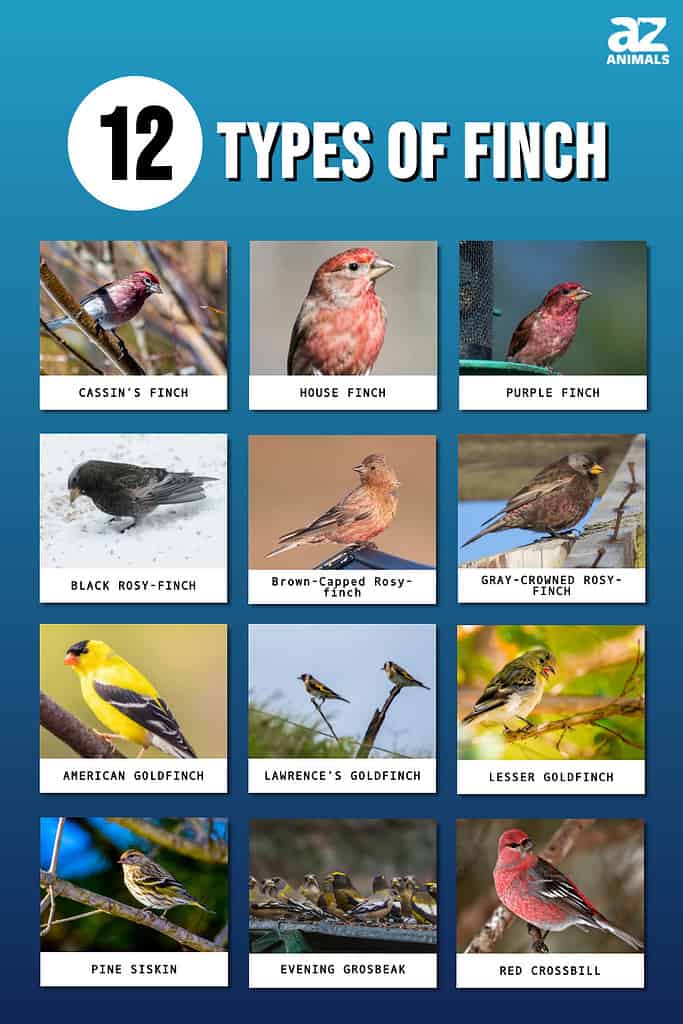
Finches are small to medium-sized birds with conical bills and colorful plumage. They inhabit a wide range of habitats and have distinctive flight calls. There are several North American finch species, which include redpolls, grosbeaks, crossbills, and siskins. Discover 12 types of finch birds and learn about their habitats, appearance, diets, and nests.
Cassin’s Finch
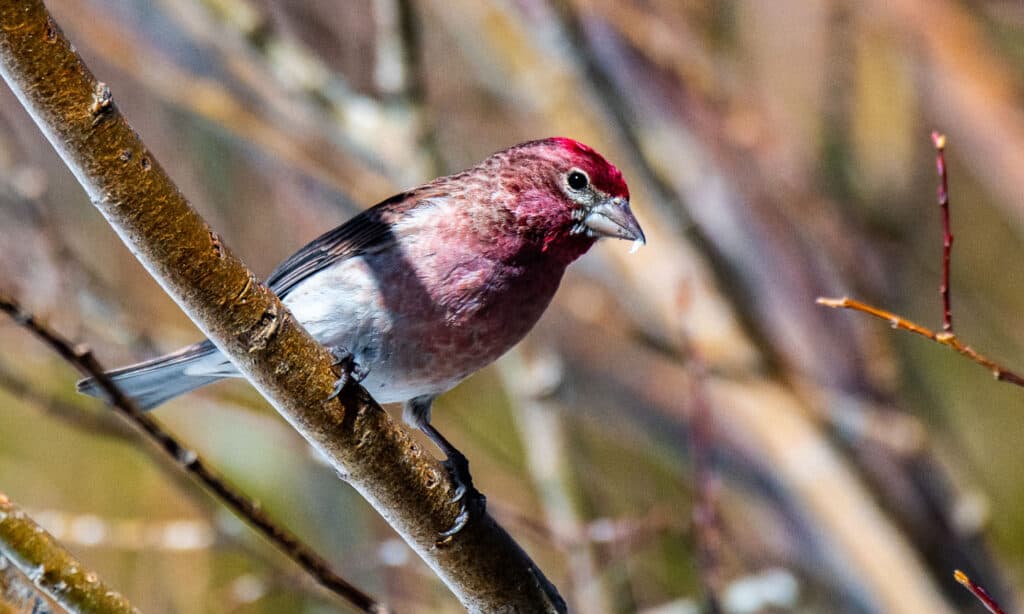
The Cassin’s finch has a chunky body with a notched tails and rosy pink plumage. They live in mature forests and sagebrush shrublands.
©Kerry Hargrove/Shutterstock.com
Habitat and Range: The Cassin’s finch is a permanent resident in the Northwestern United States. Populations that breed further north over the Canadian border migrate to the Southwest and Mexico for winter. These birds live in mature forests and sagebrush shrubland.
Features and Coloring: These chunky finches have notched tails and feature rosy pink plumage with heavy brown streaking.
Diet: Seeds, buds, and berries
Vocalization: Flutey warbles
Nests: An open twig and weed cup in large conifers
House Finch
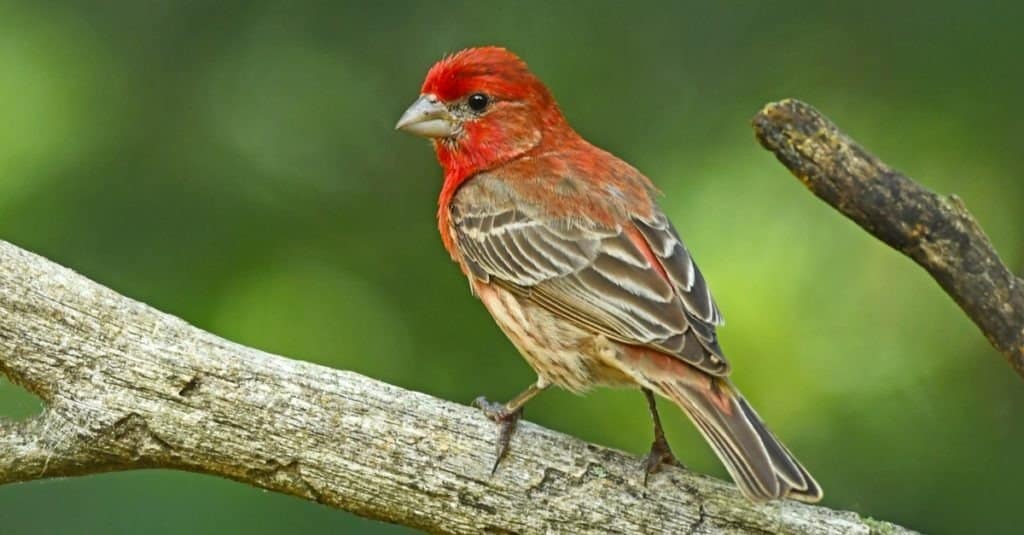
The House finch is a permanent resident throughout most of the United States. They often live near human habitations, like urban centers.
©Brian A Wolf/Shutterstock.com
Habitat and Range: House finches live year-round throughout most of the United States, except for some parts of the Midwest. They have wide-ranging habitats, but you can often find them near human habitations, like urban centers and suburban lawns.
Features and Coloring: The house finch is a small bird with a large beak and a long, flat head. They also have rosey red plumage with streaky brown backs.
Diet: Seeds, buds, and berries
Vocalization: Chirp calls and extensive warble
Nests: An open grass and weed cup placed on a variety of sites
Purple Finch

The purple finch is more reddish-pink than purple. They also have brown backs, whitish bellies, and silver conical bills.
©Fiona M. Donnelly/Shutterstock.com
Habitat and Range: The purple finch breeds in Canada and winters in the Eastern United States. Populations in the Northeast and Northwest live there year-round. They live in cool, moist evergreen forests during summer and a variety of habitats during winter.
Features and Coloring: Another small finch with a conical bill. Their bodies are chunky and feature reddish-pink heads, brown backs, and whitish bellies.
Diet: Seeds, berries, buds, and insects
Vocalization: Rich, musical warble
Nests: Compact twig cup placed on horizontal branches
Black Rosy-Finch
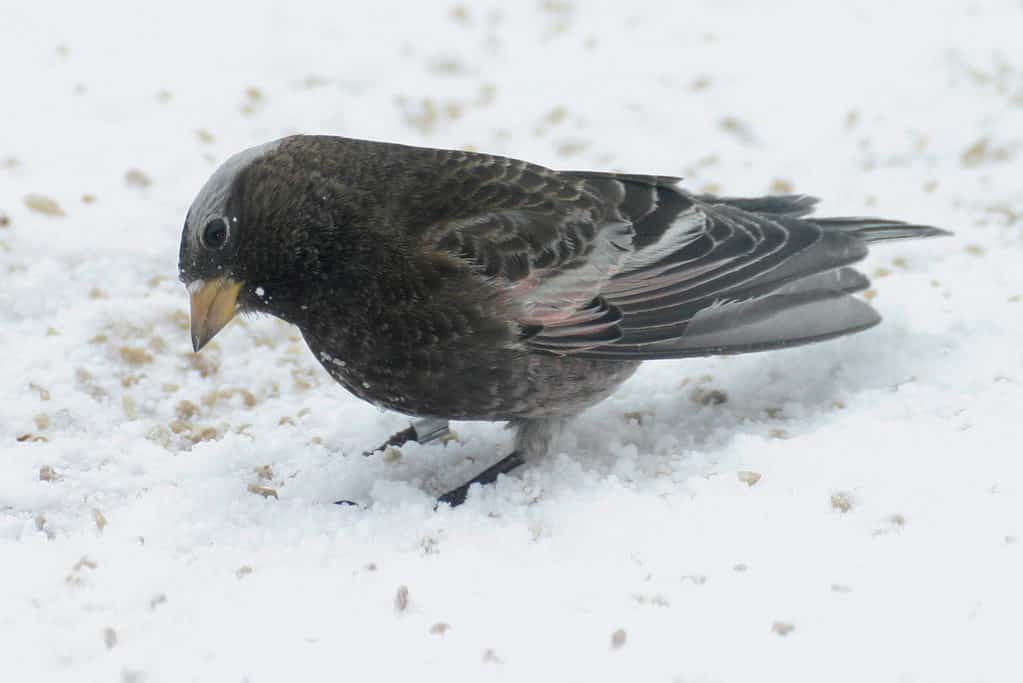
The black rosy-finch lives in the mountains of the Western United States. They breed in cliffs and rock slides and winter in parks and valleys.
©iStock.com/CedarHill
Habitat and Range: The black rosy-finch has a relatively small range in the mountains of the Western United States. They are altitudinal migrants, meaning they move to lower altitudes during winter. They breed above the treeline in cliffs and rock slides and winter in open parks and valleys.
Features and Coloring: They are medium-sized finches with black plumage and pink highlights with gray crowns.
Diet: Seeds and insects
Vocalization: Low “cheep” notes
Nests: A bulky open grass cup in a cliff crevice
Brown-Capped Rosy-finch

Brown-capped rosy finches live in Wyoming, Colorado, and New Mexico. They inhabit snowy meadows in high alpine areas.
©iStock.com/Carl Bendorf
Habitat and Range: Brown-capped rosy finches have a small range in Wyoming, Colorado, and New Mexico. They breed in high alpine areas in snowy meadows and move to lower elevations during winter, where they inhabit Rocky Mountain communities.
Features and Coloring: This stocky, medium-sized bird has a short tail and long wings. Male breeding plumage is rich brown above and rosy below with gray caps.
Diet: Insects, spiders, and seeds
Vocalization: Low “cheep” calls
Nests: A bulky moss cup in a cliff crevice
Gray-Crowned Rosy-Finch
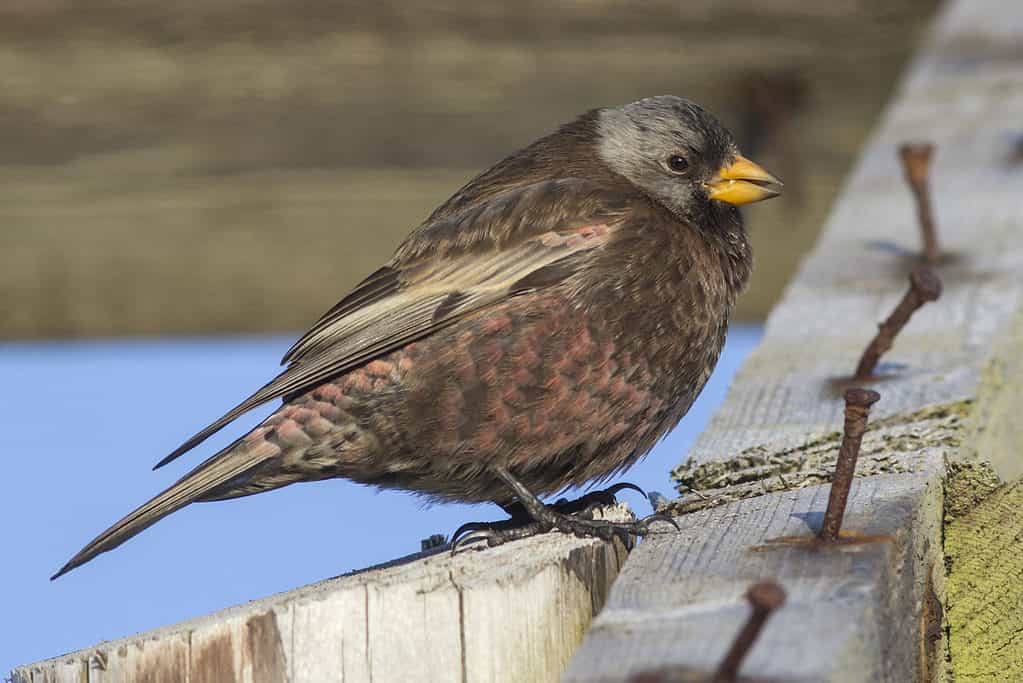
The gray-crowned rosy finch winters in the Northwestern United States in meadows and rocky hillsides.
©iStock.com/pilipenkoD
Habitat and Range: The cray-crowned rosy-finch breeds in Alaska and Western Canada and winters in the Northwestern United States. They inhabit alpine areas above the treeline, nesting near cliffs and glaciers. You can find them in meadows and rocky hillsides during winter.
Features and Coloring: Medium-sized and chunky, this rosy-finch has a short tail and short bill. They have gray heads, Brown bodies with dark streaking, and pink accents.
Diet: Seeds and insects
Vocalization: Harsh “cheep” notes
Nests: A bulky grass cup amongst boulders
American Goldfinch
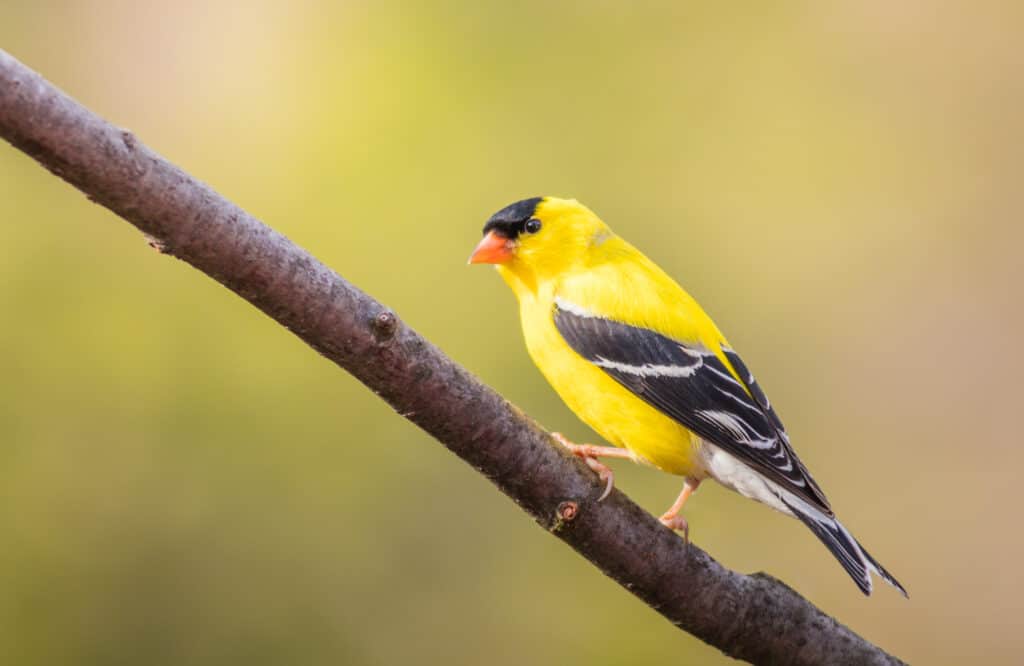
Male goldfinches are pleasing to look at with their yellow and black plumage. They have an extensive range across North America.
©Rabbitti/Shutterstock.com
Habitat and Range: American goldfinches have an extensive range across North America. They breed in Southern Canada and winter in the Southern United States and Mexico. There are also permanent populations in the Northern to Central US. They live in weedy fields and open floodplains.
Features and Coloring: The breeding male has bright yellow plumage with black wings and foreheads. Nonbreeding males are drab brown with black and white wings with yellow heads.
Diet: Seeds and insects
Vocalization: Bright “potato-chips”
Nests: A compact plant fiber cup in deciduous shrubs and trees
Lawrence’s Goldfinch

Lawrence’s goldfinch is nomadic, moving when they need to find seeding plants and water. Look for them in open woodlands and coastal scrub.
©iStock.com/JenDevos
Habitat and Range: The Lawrence’s goldfinch breeds sporadically throughout California and winters in Arizona, New Mexico, and Mexico. They are nomadic and move around throughout the year in search of seeding plants and water. They live in dry, open woodlands, coastal scrub, suburbs, and weedy fields.
Features and Coloring: These birds are gray overall with yellow breasts and wing patches. They also have black faces and streaky wings.
Diet: Seeds and insects
Vocalization: Melodious, scratchy notes
Nests: Small grass cups in trees
Lesser Goldfinch
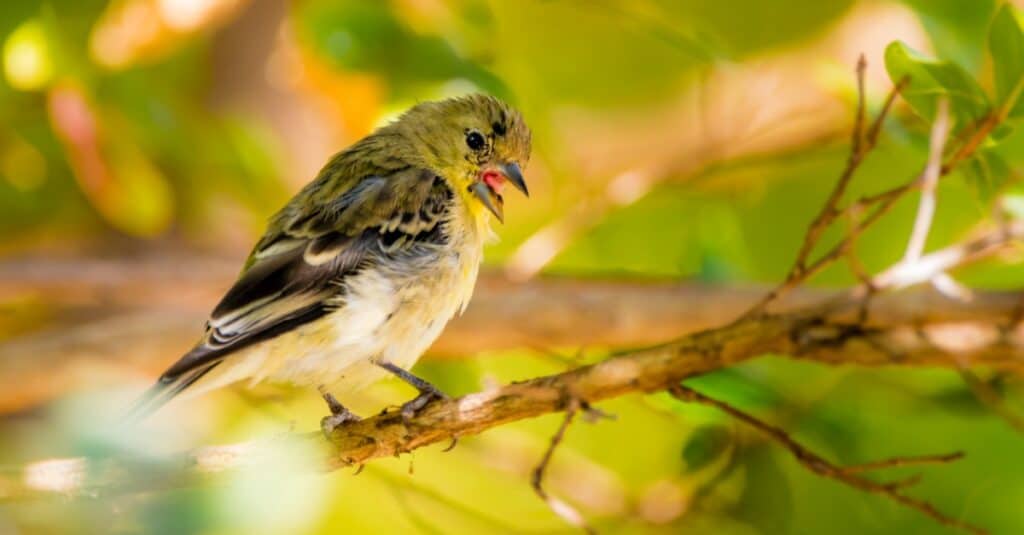
The lesser goldfinch averages around four inches in length. Males are bright yellow and glossy black with white wing patches.
©iStock.com/Sunil Singh
Habitat and Range: The lesser goldfinch has a breeding population in the Southwest, but most live year-round along the west coast and Mexico. Some also live permanently in Central and South America. They live in patchy open habitats, like thickets, woodlands, clearings, and farmland.
Features and Coloring: Males are bright yellow below and glossy black above with white wing patches.
Diet: Seeds and insects
Vocalization: Rapid twittering
Nests: A compact woven grass cup placed in vertical twig forks in bushes
Pine Siskin

Pine siskins weigh 0.4 to 0.6 ounces and measure 4.3 to 5.5 inches long. They have sharp, pointed bills and streaky brown plumage.
©Menno Schaefer/Shutterstock.com
Habitat and Range: Pine siskins breed in Canada and winter across the United States and Mexico. And some populations are permanent residents in Southern Canada and the Western US. They breed in open coniferous and mixed forests. You can also find them in parks, cemeteries, suburbs, and many other areas.
Features and Coloring: They are very small songbirds with sharp, pointed bills. These birds are streaky brown with light yellow edgings.
Diet: Seeds, vegetable matter, and insects
Vocalization: Husky, whispering trills
Nests: a Large, shallow twig cup hidden in trees
Evening Grosbeak
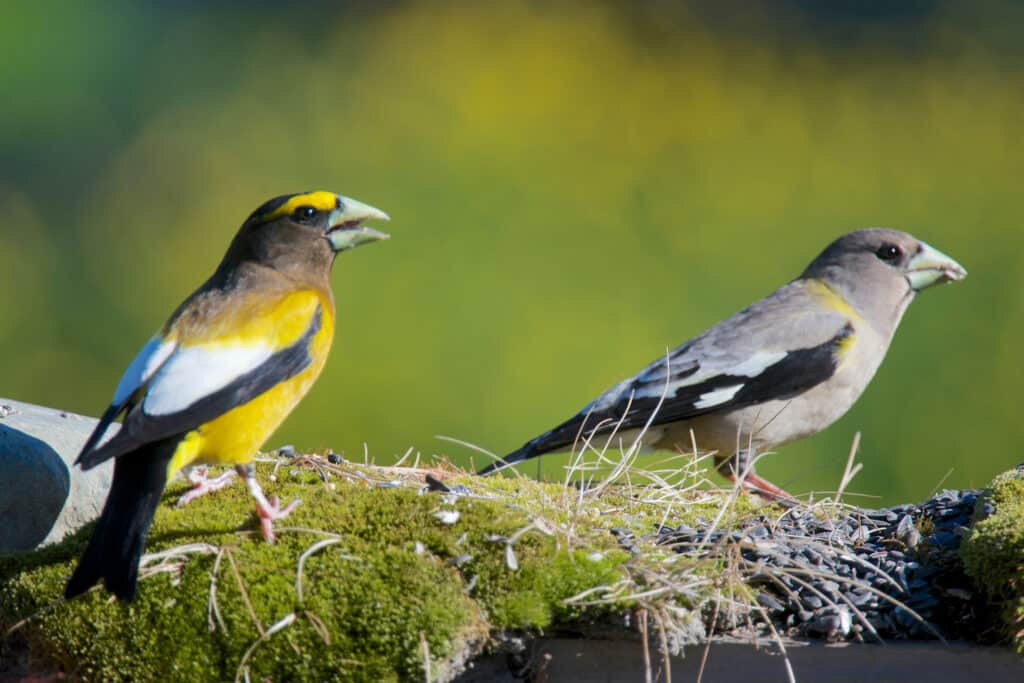
Researchers are unsure what’s causing a significant decline in the evening grosbeak population. They winter across most of the United States.
©Danita Delimont/Shutterstock.com
Habitat and Range: Evening grosbeaks live year-round in Canada and the Northwestern United States and winters across most of the US, except for the far southern regions. You can find them in mature coniferous and deciduous forests.
Features and Coloring: They are large, heavyset finches with thick bills and short tails. They have varying shades of yellow and black plumage with white wing patches.
Diet: Seeds, berries, and insects
Vocalization: Short, musical whistles
Nests: A loose twig cup placed on a horizontal branch
Red Crossbill

The red crossbill has a very unique beak, which allows it to open sources of food easily. They are permanent residents in the Pacific Northwest.
©iStock.com/bobloblaw
Habitat and Range: The red crossbill is a permanent resident in Canada, the Pacific Northwest, and parts of the Southwest and Mexico. They winter across the rest of the United States, except in the Southeast. They inhabit mature coniferous forests.
Features and Coloring: They are medium-sized finches with crisscrossed bills, featuring brick red plumage and dark wings and tails.
Diet: Conifer seeds
Vocalization: Sweet, loose trills
Nests: A bulky, loose twig cup placed on a horizontal conifer branch
Bonus: How to Attract Finches to Your Home
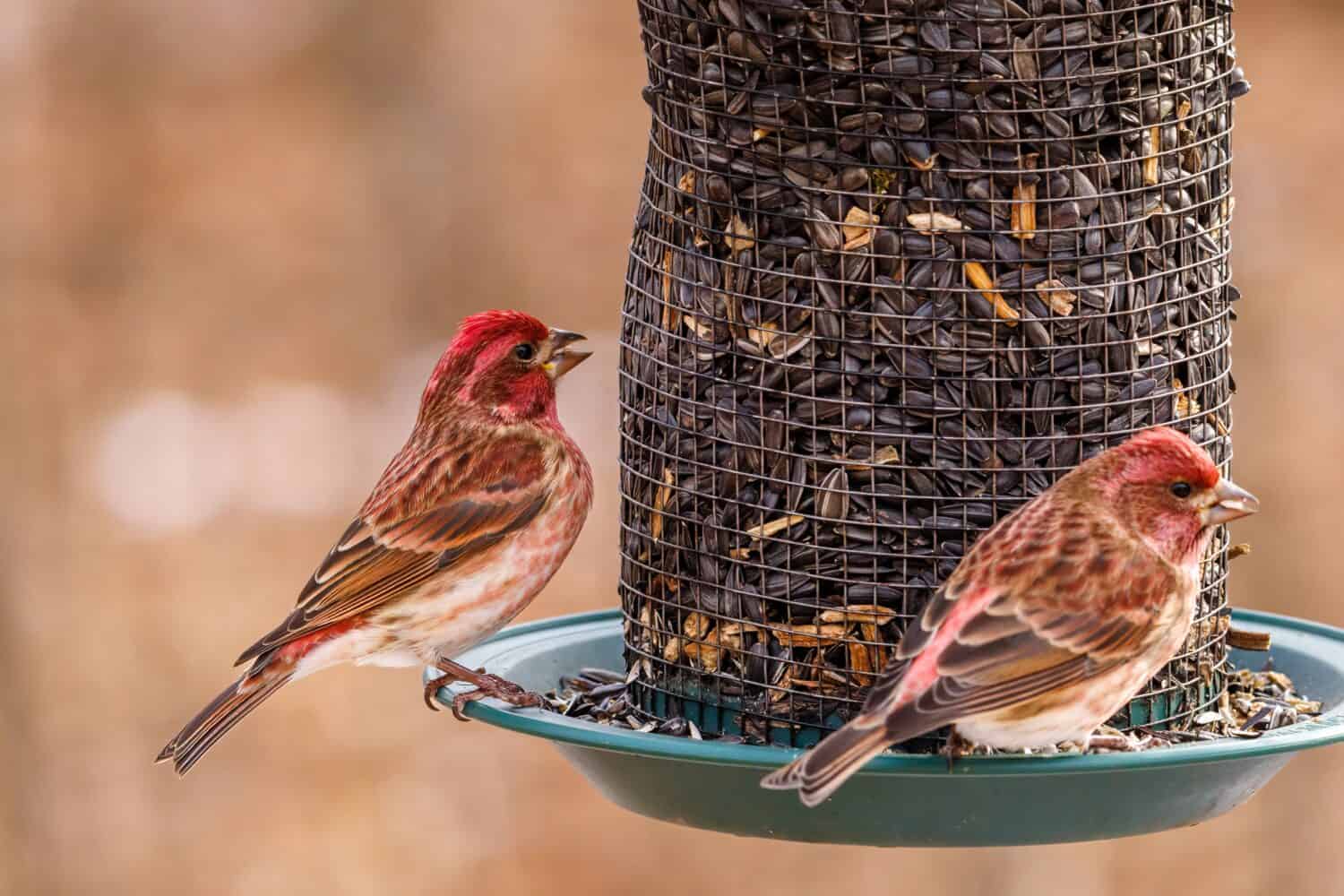
Finches are delightful songbirds that are fun to watch.
Image: Aaron J Hill, Shutterstock
©Aaron J Hill/Shutterstock.com
Finches of all types are a delight to see and hear whenever they visit your yard or garden. While bird experts don’t always recommend feeding wild birds – there’s no question that it provides pleasure for both the human and the birds! Here are some ways that you can attract these lively little birds to your home:
- Place your feeders where finches feel safe. The best spot is near a tree or shrub during the introduction period – but you can move it far enough away that squirrels can’t jump to it after the finches have claimed it.
- Fill the new feeder halfway. It may seem odd, but for some reason, a new half-full feeder seems to be more attractive to birds.
- Provide fresh black seed. Finches won’t feed on old-looking brown seed. Press on the seed with your fingernail – if oil comes out – your finches are sure to love it! Thistle seed can be stored in the freezer until you use it to preserve freshness.
- Add brightly colored ribbons or plants. Birds are attracted to bright colors and ribbons blowing in the wind make them believe that another bird has already tested and approved the feeder.
- Keep your finch feeder clean. Finches don’t like dirty feeders – especially clumped food that has gotten wet after it rains.
- Plant seed-bearing plants. Flowers in bloom and seed-bearing plants like sunflowers and pinecones attract birds.
- Provide black oil sunflower seed. Finches love the high-fat content! While it won’t fit into a thistle feeder – another feeder with this offering will attract all types of birds along with the finches.
Summary of 12 Types of Finch
| Finch | Location | |
|---|---|---|
| 1 | Cassin’s Finch | Northwestern and Southern US and Mexico |
| 2 | House Finch | Most parts of the US |
| 3 | Purple Finch | Canada and Eastern US |
| 4 | Black Rosy-Finch | Western US |
| 5 | Brown-Capped Rosy-finch | Wyoming, Colorado, and New Mexico |
| 6 | Gray-Crowned Rosy-Finch | Alaska, Western Canada, and Northwestern United States |
| 7 | American Goldfinch | Throughout the US and Mexico |
| 8 | Lawrence’s Goldfinch | California, Arizona, New Mexico, and Mexico |
| 9 | Lesser Goldfinch | The west coast of the US, Mexico, Central, and South America |
| 10 | Pine Siskin | Southern Canada, Mexico, and the Western US |
| 11 | Evening Grosbeak | Canada and the Northwestern United States |
| 12 | Red Crossbill | Canada, the Pacific Northwest, and parts of the Southwest and Mexico |
The photo featured at the top of this post is © Steve Byland/Shutterstock.com
Thank you for reading! Have some feedback for us? Contact the AZ Animals editorial team.






